
California Broomrape
Aphyllon californicum subsp. californicum
Watering:
Minimal
Hardiness Zone:
Sun:
full sun,part shade
Leaf:
Yes
Growth Rate:
Low
Drought Tolerant:
Yes
Salt Tolerant:
Yes
Care Level:
Medium
watering
Western Lady's Mantle (Aphanes occidentalis) is best watered twice a week during the growing season,spring through fall.In the winter, water sparingly once a month.It prefers moist soil, so check the soil with your finger for moisture before watering. If the soil is still moist, you can wait to water. When watering, be sure to water thoroughly until water is seen to come out of the bottom of the pot. Do not allow the plant to stand in water.
sunlight
Western Lady's Mantle requires at least 6 hours of direct sunlight each day for it to thrive. This can come in the form of morning sun, when the sun is at its weakest and at its highest in the sky, or mid-day to mid-afternoon sun. During the peak of summer, the plant will benefit from having some level of shade present, as the sun's intensity can be too strong for its needs. When located in an area with more intense sunlight, the plant may need to be given some extra protection from the sun's rays to ensure it does not experience damage.
pruning
Western Lady's Mantle (Aphanes occidentalis) typically requires minimal pruning, and should only be pruned in early spring before any new growth emerges. Pruning at this time helps to maintain the desired size and shape of the plant, and to remove any dead or obviously damaged foliage or branches. It is not necessary to routinely prune Western Lady's Mantle as it does not require it to remain within a particular size or shape. However, if dead, damaged or diseased parts become apparent, they should be removed to promote healthy growth.
